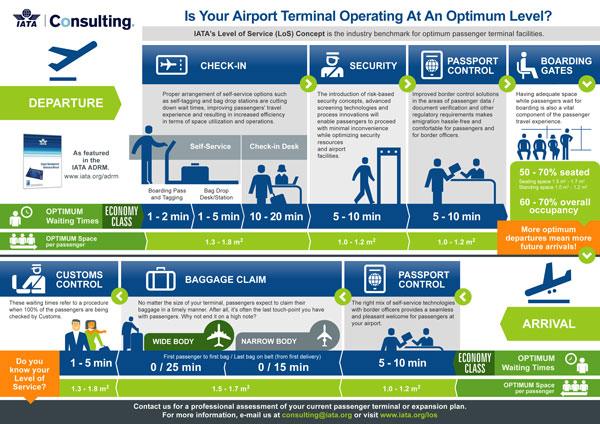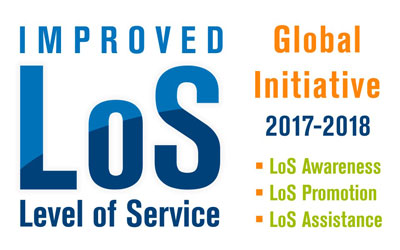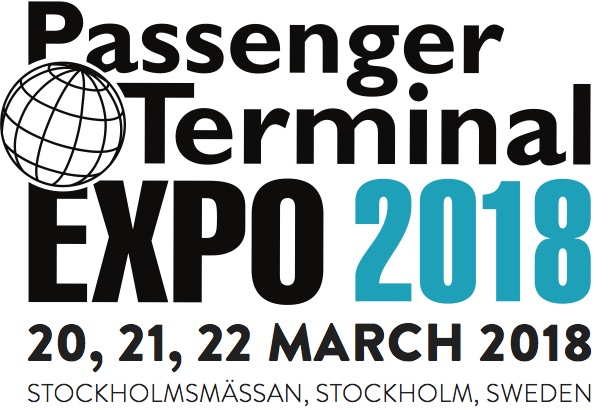IATA to promote Level of Service at Passenger Terminal EXPO 2018
| Press Release Date | 21.02.2018 |
|---|
 The International Air Transport Association (IATA) will be taking a booth at this year’s Passenger Terminal EXPO, which takes place 20-22 March, in Stockholm, Sweden, to help promote its Level of Service (LoS) program and to explain how it can help airports get the most out of their existing terminal facilities, as well as plan for the future.
The International Air Transport Association (IATA) will be taking a booth at this year’s Passenger Terminal EXPO, which takes place 20-22 March, in Stockholm, Sweden, to help promote its Level of Service (LoS) program and to explain how it can help airports get the most out of their existing terminal facilities, as well as plan for the future.
In an exclusive interview with Passenger Terminal World magazine, IATA’s LoS project lead, Jurgen Renner runs us through the basics:
What is Level of Service (LoS) and how is it different from ACI’s Airport Service Quality program?
LoS is based on a quantitative assessment of three key performance indicators: space per passenger, maximum waiting times and occupancy (relating to boarding gates only). The LoS Assessment is conducted during typical busy periods and relates to all passenger processing and holding facilities within the terminal. The ACI ASQ on the other hand, is a benchmarking programme based on qualitative feedback from passenger surveys and takes into account a broad range of terminal service areas.
In addition, LoS can be used to assess whether your airport’s infrastructure is optimised for current and projected operations, whether the CAPEX and OPEX are adequate and whether contractual obligations are being met. Finally and importantly, we can make suggestions for improvements.
What does it cost and how can airports get a return on their investment?
The costs of the LoS Assessment mainly depend on the complexity and size of the terminal facilities, as well as on the selected study approach.
If an airport just wants to know where it currently stands in terms of provided service levels, then a simplified assessment might be sufficient. This approach is very cost-effective and gives the airport a good initial understanding of its present situation. IATA can typically deliver this kind of LoS study in 6-8 weeks.
If an airport also wants to know how its LoS will evolve in the future, a more sophisticated assessment is required. In that case, IATA will use simulation technology to predict future passenger flows and identify the expected LoS at each of the terminal sub-systems. That way, we can identify potential capacity bottlenecks and provide recommendations for improvements, to achieve an optimum LoS. The simulation tool also allows us to validate whether the proposed optimisations are actually effective and result in an improved LoS. Of course, a more sophisticated approach like that is more expensive and time-consuming, requiring a approximately 4-6 months.
Our assessment aims to achieve an optimum LoS at all terminal facilities. Optimum terminal facilities have three main attributes. Firstly, they offer sufficient space to accommodate all necessary functions in a comfortable environment. Secondly, they provide stable passenger flows with acceptable waiting times and finally, they keep the overall investment costs and operational expenses at reasonable levels, while offering a good level of service and comfort to passengers.
These advantages eventually lead to more happy passengers – who will also tend to spend more time and money in the commercial areas, because they aren’t stuck in long queues during the various departure processes.
 Based on the results seen so far, where do airports still have the most work to do?
Based on the results seen so far, where do airports still have the most work to do?
We have conducted quite a few of these LoS Assessments during recent years. Most of the time we see that airports face poor service levels during the departure and arrival peak periods, particularly at critical sub-systems such as passport control. These are managed by government entities and adequate staffing is essential here to achieve good performance.
Why is the amount of space required different for each stage of the passenger journey?
On departure, the first sub-systems (public departure hall and check-in) require the most space per passenger as the travellers still have to carry their bags or use baggage carts. After they have checked-in their luggage, the space requirements decrease as the passengers then only have carry-on items with them and need less space while queuing or walking around. The same principle applies at arrivals, where there are higher space requirements starting from baggage reclaim.
Which factors have the greatest impact on waiting times?
Waiting times are typically a result of the quantity of the processing facilities and the individual processing times – for example, the number of open security lanes and the time it takes for an individual to complete the security process. We sometimes see huge differences, especially in the average processing time per passenger.
Modern security lanes can handle several passengers at the same time and therefore achieve a high passenger throughput capacity. Conversely, old screening equipment with a bad configuration and inefficient operation of the checkpoint results in high average processing times, thus low throughput capacity.
 IATA speakers at Passenger Terminal CONFERENCE
IATA speakers at Passenger Terminal CONFERENCE
IATA will once again provide several speakers to share the association’s unique insights and experiences with the audience at this year’s Passenger Terminal CONFERENCE. As part of the Aviation Security, Border Control & Facilitation track on Thu 22nd March 2018, Celine Canu, IATA’s head of aviation facilitation will present ‘Optimising passenger data transmission to enhance aviation security.’ “Aviation security has traditionally focused on preventing the introduction of prohibited items in the security restricted areas as opposed to trying to identify potential perpetrators, which has long been an impossible exercise,” explains Canu. “The modernisation of passenger data transmission is a key factor to enhance the early identification of high-risk passengers.”
Celine is also the secretary of the IATA Facilitation Working Group, a key forum where airline, airport and government representatives work together to shape joint positions. Meanwhile, on Wed 21 March, as part of the Airport Design, Planning & Development – Middle East & Asia track, Kashif Khalid, CM (Gulf Region), IATA, will present ‘Airport development and PPPs in the Middle East’.
The presentation will provide an overview of CapEx plans and airport projects in the Middle East, the nature of the procurement process, how governments are building those facilities (PPPs versus government equity, for example) and opportunities that exist.
Kashif is currently leading IATA projects in the Middle East, providing leadership and guidance to airlines, airports, ANSPs, civil aviation authorities, security agencies and the Gulf region’s governments to further develop IATA’s mission, projects and advocacy initiatives. Finally, Sylvain Campeau, manager passenger, IATA, will take part in a panel discussion titled ‘Data exchange in the aviation industry’ during the Technology – Passenger Journey track on Tue 20th March 2018.

